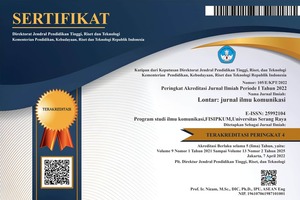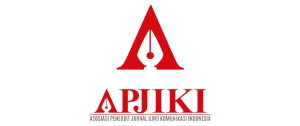Audio-post Company Communication Strategy in Jakarta on Maintaining Client Loyalty in Television Advertising
DOI:
https://doi.org/10.30656/lontar.v11i1.6167Keywords:
Communication Strategy, Marketing Communication, Audio-post, Cut2Cut studio, Television CommercialAbstract
The visual package of an advertisement on television will not be communicated perfectly to the audience if it’s not supported by good audio quality and those who have a role in making audio in television advertisements are audio-post companies. Advertising spending in Indonesia continues to increase every year by seven percent and dominated by television commercial with a total of 79.2 percent. Based on this, more and more audio-post companies are emerging now that produce audio for television commercial in Jakarta and certainly makes competition in this industry more obvious. But even so, they still have their loyal clients that have stayed from the past until now. One of these audio-post companies is Cut2Cut studio, which was founded in 2002 and has loyal clients from well-known brands. Therefore, this study aims to find out how Cut2Cut studio's communication strategy maintains client loyalty to television commercial. The method used is qualitative with a case study approach. The results of the study state that Cut2Cut studio carries out several strategic stages including formulating strategies that focus on approaching clients, implementing strategies by maintaining communication with clients as well as providing special treatment, as well as evaluating strategies by conducting routine evaluations based on obstacles that need to be discussed
References
Adelina, L. & Ritha, D. (2021). The Effect of Corporate Communication and Service Quality on Customer Loyalty and Satisfaction in Sharia Banking. Jornal of Asian Finance, Economics and Busines. 8(3). 1267-1274.
Aeker, David A.1991.Managing Brand Equity.New York,NY:The Free Press
Azizah, Nur dkk. (2020). Strategi Pemasaran Iklan Go-Jek Versi Cendikiawan Untuk Meningkatkan Pengguna Aplikasi Gojek. Jurnal Ilmu Komunikasi Lontar Vol. 8 No. 1.
Creswell, John W, (2015) Research Design :Pendekatan Kualitatif, Kuantitatif, dan Mixed (Achmad F, Terjemahan). Yogyakarta:Pustaka pelajar
David, Fred R. (2002) Manajemen Strategi dan Konsep. Jakarta : Prenhalindo
Fitrah, F. & Choirul, F. (2019). Communication Strategy of Dinas Komunikasi Dan Informatika Daerah Istimewa Yogyakarta in Socializing Jogja Smart Province Program Amongst the Jogjakarta Society. Education and Humanities Research. Vol 423. 145-156.
Griffin, Jill. (2002) Customer Loyality Menumbuhkan dan Mempertahankan Kesetiaan Pelanggan. Jakarta: Erlangga
Gülçin, I. & Ali, Ş. (2022). Communication Strategies Used in Corporate Facebook Pages and Motivations of Consumers for Following These Pages. European Journal of Marketing and Economics. 5(2). 42-63
Kottler, Philip. Dan Kevin Kane Keller. (2005) Manajemen Pemasaran, edisi Bahasa Indonesia. Jakarta: PT. Indeks
Leadya, R. , Rosanti, U, & Sayida M. (2021). Strategi Komunikasi PT. Pos Indonesia dalam Meningkatkan Reputasi Perusahaan. Jurnal Digital Media & Relationship, 3(1), 30-42.
Made, D. & Desi, D. (2010). Internal Communication Towards Employee Engagement Inside Sultan Agung Islamic University (Unissula). Jurnal Ilmiah Komunikasi : MAKNA. 1(1). 1-14
Marta, S. & Winki, O. (2013). Strategi Komunikasi Organisasi Pt Tigamata Indonesia Dalam Menjalin Hubungan Dengan Pelanggan Periode Maret-Juni 2013, Humaniora, 5(2), 1161-1167.
Mohamad, Bahtiar. Dan Burhan Bungin. (2020) Coorporate Communication. Jakarta: Prenadamedia
Ni Luh Putu, S. (2019). Strategi Komunikasi dalam Meningkatkan Kinerja Karyawan di BHR Law Office. Jurnal Ilmiah Manajemen & Bisnis, 4(2), 115-124
Niken, D. I Wayan, S. (2022). Penerapan Strategi Komunikasi Humas PT.KAI (Persero) dalam Upaya Peningkatan Kualitas Pelayanan. J-Dinamika, 7(1), 156-162.
Ruliana, Poppy. (2014) Komunikasi Organisasi : Teori dan Studi Kasus. Jakarta: Rajawali .
Thomas M Scheidel(1976). Speech Communication And Human Interaction. Glenville, III.Scott, Foresman dan CO.
Yin, Robert K. (2003). Case Study Research : Design and Methods (3rd Ed). California: SAGE Publication
Downloads
Published
Issue
Section
License
By submitting an article to the journal, the author(s) agree to transfer the published article's copyright to the journal, which will act as the publisher. This means the journal will have the right to publish the article in various forms, including reprints. The journal will maintain the publishing rights to the published articles.
In line with the license, authors and third parties (readers, researchers, and others) are allowed to share and adapt the material. In addition, the material must be given appropriate credit, provided with a link to the license, and indicated if changes were made. If authors remix, transform, or build upon the material, authors must distribute their contributions under the same license as the original.





